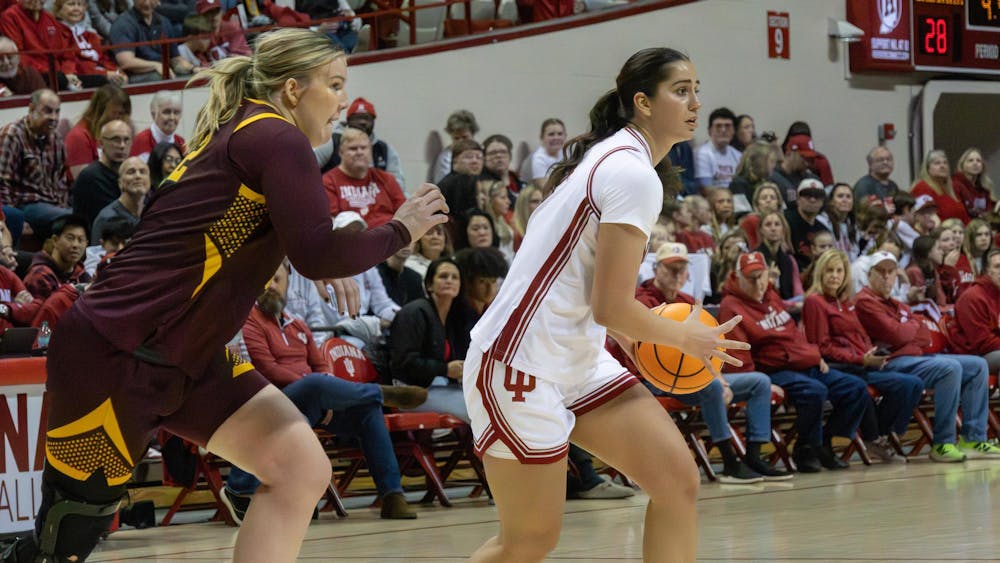Ralph Zuzolo has been producing videos at IU for 27 years.
The video team manager recorded some of his earliest projects on older video formats, such as video cassettes.
In a few years, the equipment needed to view such videos may no longer exist, Zuzolo said.
But a recent $15 million University initiative could make it possible for anyone to access Zuzolo’s decades of work online.
“It’s nice to know that projects I worked on and people I interviewed a long time ago will be preserved,” Zuzolo said.
IU President Michael McRobbie announced in last week’s State of the University address his goal to digitize IU’s time-based media collections by 2020.
University Information Technology Services and IU Libraries will work to assemble, digitize and organize the time-based media by IU’s Bicentennial.
Time-based media includes all forms of media that can be “played,” such as podcasts and newsreels.
The Media Preservation and Digitization Initiative will be led by Vice President for Information Technology Brad Wheeler, Vice President for Research José Jorge and Dean of Libraries Brenda Johnson.
“We are increasingly moving into an era in which if ‘it’s not digital, it doesn’t exist,’” Wheeler said. “We have become accustomed to a world where almost everything is at your fingertips.”
The Indiana Media Preservation Access Center will provide the preservation and access digitization services necessary to preserve 284,000 audio recordings, 66,000 video recordings and 58,000 films, all within 15 years, according to the IMPAC website.
According to the digitization proposal published on the Media Preservation Initiative website, digitization is necessary to preserve IU’s media collections not only for easier access, but because the physical copies of these collections are deteriorating.
“If you needed to play a reel-to-reel audio tape right now, how many of those machines could you find in your apartment complex? None,” Wheeler said. “Preserving the media itself probably has limited value for some amount of time if there are no longer devices that are capable of even playing it.”
IU is the first university of its kind to embark on a digitization process such as the MPDI, Wheeler said.
“It’s already raised some eyebrows with other provosts,” Wheeler said. “Some universities may not be in a position to be able to go after that. We have the possibility of becoming a service operator for other universities who may want to ship collections here to have them digitized.”
Wheeler said the project would allow any individual to quickly find and access an IU video, whether it is an important speech or a winning basketball shot.
The proposal includes “obsolescence notes” detailing the projected lifespan of each format as well as its accessibility based on the number of access systems produced per year.
The digitization process will begin with a selection of materials. The process will be similar to the Google Book search project in Ann Arbor, Mich., where Big Ten universities participated in selecting books, going through the digitization process, returning the books to libraries and organizing the digital files, Wheeler said.
The MPDI would help IU’s libraries improve their archiving and preserving of culture, said Monique Threatt, head of media and reserve services for Herman B Wells Library.
The Wells Library contains more than 10,000 video cassettes that are rare or out-of-print, Threatt said.
“We have been waiting with anticipation that the proposal would get funded,” Threatt said.
The money going into the initiative will be worth the University’s assets, Threatt said.
After the media have been digitized, IU will add metadata to the items. Metadata includes copyrights, search terms and collection placement to improve search
queries.
“Metadata is hugely important to making media searchable and findable,” Wheeler said.
After the digitization process, the materials will be placed in storage facilities, such as temperature controlled rooms.
“The work will be quality checked to make sure the digitized media is in full fidelity and returned to proper place for storage,” Wheeler said. “Some of the most rare and precious materials will be handled internally. In the end, the collections will be made available through the IU library.”
Even though digitizing time-based media collections is a priority for IU, digitizing other tangible collections, such as the materials in the Lilly Library, is not.
“Man, the serendipity of coming across something that you might not find just by search terms,” Wheeler said. “I see digitization as an amplifier of what we have there. Students and scholars will still want to go to those collections and visit them.”
But for Zuzolo, a video team manager for UITS, digitalization means future generations will be able to use videos such as his as a research tool.
Zuzolo said digitization “saves IU’s history that has been captured in video, film and audio that could have been lost if this initiative hadn’t taken place.”
Zuzolo credits IU’s information technology capabilities to the MPDI’s potential.
“We have such a large, robust IT infrastructure here at IU,” Zuzolo said. “That gives us an advantage in such an undertaking ... We have the IT ability, the interest of parties and people who have the knowledge to move forward.”
Follow reporter Hannah Alani on Twitter @HannahAlani.
University taps $15 million to digitize audio, video media
Get stories like this in your inbox
Subscribe





